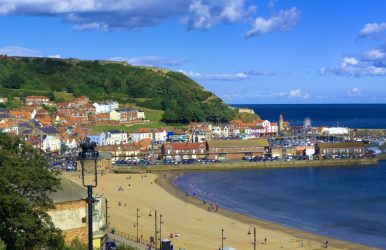Scarborough Secrets: Your Ultimate Guide To Coastal Charms
BY Abdul Aziz Dec 1, 2023
For those who want to get away from city life, Scarborough's top attractions provide an amazing holiday experience. One of the most well-known coastal resort towns in England, it embodies the traditional historical charm. It is dotted with arcades, fish and chips, and waterfront parks. The essence of Scarborough is some of the nation's nicest beaches at the base of sheer cliffs. This seaside town in Yorkshire has the atmosphere of being stuck in the Victorian era. Perched atop the cliffs, the Grand Hotel commands attention from all directions. The Scarborough Spa continues to draw national visitors. The town's architecture is characterized by a lot of flamboyant buildings with a hospitable old-world charm. In this article, we will enumerate all the things to do in Scarborough you cannot miss. Things To Do In Scarborough Even with its historical vibe, Scarborough is still a lively and welcoming spot to spend a summer in England. South Bay Beach Scarborough's South Bay Beach is well-known for its soft sand, amusement arcades, donkey rides, and the Grand Hotel perched atop cliffs. Like a vacationer from the Victorian era, you can still take the historic cliff lifts from the hotel down to the beach. Though the North Sea is far less inviting, South Beach can be just as busy and enjoyable on a sunny summer's day as any beach in the Mediterranean. While it's usually acceptable to dangle your toes in, very few people go deeper than knee depth. North Bay Beach, located on the opposite side of the headland, has earned a Blue Flag designation for hygiene. Though it has fewer nearby attractions than South Bay Beach, it is usually busier on nice days. Rotunda Museum The exhibit at the Rotunda Museum covers the region's incredibly old history. The collection's highlights include a Bronze Age coffin, Stone Age tools, and dinosaur fossils. These intriguing objects are arranged in an equally intriguing and historic structure. One of the first purpose-built museums in history, the ancient circular structure with its trick-eye ceiling is just as fascinating to look at as the artifacts. The Scarborough Art Gallery, the famous Grand Hotel, the historic Spa Bridge that spans a valley with beautiful parkland, and the Rotunda Museum's distinctive exterior are all nearby. It's a major center of culture. Scarborough Market Hall & Vaults Renovated historically, the Scarborough Market Hall & Vaults houses a contemporary market with a nod to the past. There is local produce available in the main hall. It also has stalls offering handcrafted jewelry, presents, clothing, and artwork, among other items. Under the hall, in The Vaults, are more shops with a focus on antiques and handmade goods. In addition to being a place for shopping, Scarborough's market and hall also double as a cultural hub, hosting a calendar of special events. Additionally, there's a great food court with a view of the hallway. Scarborough Harbor Scarborough's historic harbor has long served as the city's center. It should come as no surprise that the harbor is home to several top-notch seafood restaurants, given that the fishermen still bring in their fresh catches on a daily basis. The classic fish and chips, which can be found at excellent establishments like Winking Willy's, First Catch, and Harbour View Café, is, of course, the dish of choice. As the name implies, Harbour View provides beautiful views of the old lighthouse across the protected moorings. You can help yourself to a traditional portion of English fish and chips wrapped in paper and savor it with a wooden fork. It is an English version of a takeout. A generous amount of vinegar gives the dish a unique tang and softens the crispy batter surrounding the flaky cod or haddock. Scarborough’s Old Town Not only do the winding old streets behind the harbor and South Bay Beach have a lovely, old-world charm, but they also have a fantastic assortment of stores and cafés. A few major high street names, such as Marks and Spencer and New Look, are present, but the bulk of the stores are tiny local businesses that sell some unusual and interesting goods. The selection of confectionery stores in Scarborough is particularly good. Seaside sticks of rock are boiled sugar candies is an English classic. There are plenty of other sweet options for you to choose from Additionally, there are a good number of casinos and amusement arcades. Stephen Joseph Theatre Scarborough boasts an active theater scene with a number of excellent locations scattered throughout the small town. The Stephen Joseph Theatre is one of the greatest. It's conveniently located next to the Scarborough Spa. They feature a combination of contemporary and classic shows, and the performances are excellent, even though it's unlikely that you'll see many well-known actors on stage. You won't have any trouble seeing or hearing the plays because of how small the theater itself is. There are several eateries close to the contemporary location, along with a decent bar and a small art gallery on the premises. When there isn't live action, the theater frequently screens old films and occasionally streams significant international events. Peasholm Park Peasholm Park offers both peaceful reflection and moments of excitement. During the summer (June to August), every Saturday at 3 p.m., model warships battle on the large lake near the beach, with the addition of aircraft and explosions to the action. You can rent a boat and go rowing around the large central island. It has a distinctive Japanese pagoda in the center when the miniature navies aren't in action. To explore the stunning hidden garden located at the other end of the park, stroll among the trees beside Peasholm Beck if you'd rather stay on dry land. Along the route, there are some exotic tree species like Chusan palms and American red oaks. Scarborough Spa Its distinctive history and location are what make this specific live music and events venue intriguing and worthwhile to visit. Constructed during the Victorian era, the spa is situated on the cliffs with a stunning view of South Bay Beach. Despite its historical appearance, it is equipped with contemporary amenities. One of the few seaside orchestras that still performs in the Spa plays lively classical music and classic oom-pah tunes under the sea breeze. It is a tradition they have brought down just like they did in the heyday of the town. It is a very memorable performance because of the setting, which can be either the Grand Hall or the suncourt. Since they only perform in the summer, make sure to schedule your travel and hotel well in advance. Wrapping Up The North Sea laps the picturesque, horseshoe-shaped bay at the heart of Scarborough. It is a seaside town, ruled over by a castle dating back to the 12th century. Over four centuries of sandy beaches, surfing, and hearty Yorkshire fare have made Scarborough a family favorite. If you have thoughts to share or questions to ask about things to do in Scarborough, please leave a comment below. We would love to hear from you! Read Also: Exeter’s Hidden Treasures: My Offbeat And Unique Experiences In Exeter! Things To Do In Leeds: Dive Into The Dynamic Heart Of Yorkshire Hidden Gems: Unearthing The Best Things To Do In Nottingham











